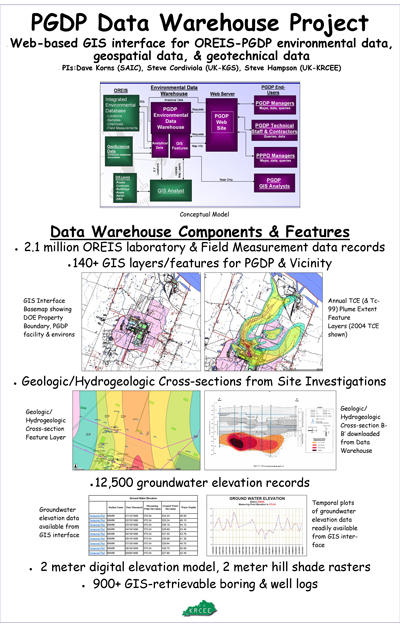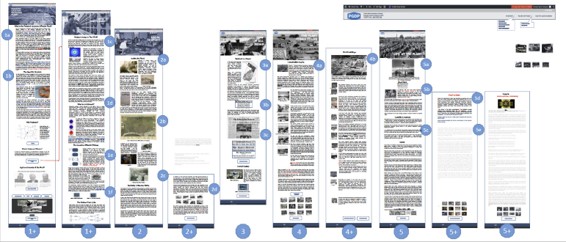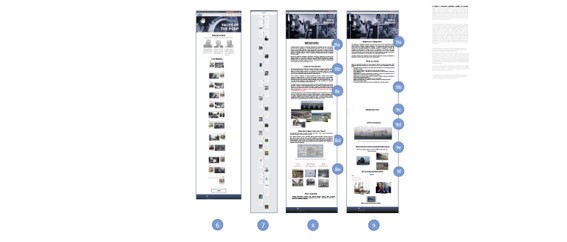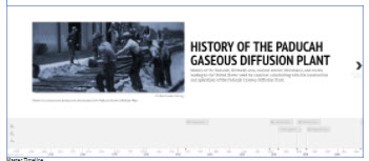IT Support for PGDP
Restoration and Reuse
BACKGROUND
Environmental activities at large industrial facilities, such as the PGDP, generate vast amounts of physical, chemical, spatial, and temporal data from operations, environmental management, health and safety actions, and regulatory compliance. Once collected data must be housed, managed, related, retrieved and distributed in a variety of formats which serve the needs of end-users practicing many disciplines.
By 2005 the PGDP had accumulated over 2.1 million environmental monitoring data records, millions of attributes related to those records, and an immense collection of related physical and geotechnical data kept as paper records. KRCEE and the DOE Portsmouth-Paducah Project Office evaluated existing web-based data storage and retrieval systems that linked environmental data to GIS and geospatial data. A decision was made to adopt and enhance an existing “Data Warehouse –GIS” System developed for managers and contractors internal use at the Portsmouth Gaseous Diffusion Plant.
DATA ACCESS, ASSESSMENT, AND VISUALIZATION
The Paducah Data Warehouse and GIS System (DWGIS) Project began in 2005. Technical, regulatory and public uses of PGDP spatial and environmental data were identified through collaborative efforts of KRCEE, Scientific Applications International Corporation (SAIC), DOE-PPPO & PGDP staff, DOE-contractor personnel and the Kentucky Geological Survey.
During DWGIS development, user’s data needs were translated into basic tools and system capabilities that allowed web-based geospatial data access and database access to PGDP environmental data. Recommendations for DWGIS tools and architecture were developed and delivered to DOE-PPPO as part of DWGIS Project Team development activities.
In 2006, KRCEE submitted the beta-tested PGDP-DWGIS and the original DWGIS User’s Manual to the DOE-PPPO.
In 2011, DOE and its site contractors, LATA KY and Swift & Staley, released the Paducah Environmental Geographic Analytical Spatial Information System (PEGASIS) and provided internal and public access to the former Paducah DWGIS. PEGASIS can be accessed at https://pegasis.pad.pppo.gov/.
Project Team
David Korns (Principal Investigator), Scientific Applications International Corporation
David Taylor, U.S. Department of Energy, Portsmouth Paducah Project Office
Dr. John Volpe, KRCEE
Dr. Rich Bonczek, U.S. Department of Energy, Portsmouth Paducah Project Office
Tracey Bugg, Scientific Applications International Corporation
Bruce Phillips, Navarro Research and Engineering
Steve Hampson, KRCEE
Project Documents
DEVELOPMENT AND MAINTENANCE of the KRCEE WEBSITE
KRCEE, KWRRI and CAER staff developed and have been maintaining a KRCEE website since 2004. The current KRCEE website is the 5th website update and 3rd major website redesign. The current design has been finalized and posted to the World Wide web.
Project Team
Tessa Pinkerton, UK Center for Applied Energy Research
Steve Hampson, KRCEE
Project Documents
| Project Document | Draft Website .pdf |
SUPPORT FOR PADUCAH DWGIS
From calendar years 2011 to 2021, KRCEE staff and contractors routinely participated in Paducah DWGIS Workgroup activities. The workgroup meets monthly to address database technical, development and upgrade issues related to the PEGASIS deployment.
During calendar years 2018 -2020, KRCEE and the Kentucky Radiation Environmental Monitoring Laboratory (REML) developed and delivered a comprehensive SQL query. The Query automates assignment of Detect/Non-Detect (DETECT column) and radiation data quality assessment (DATA_ASSESSMENT column) attributes to 400,000 radioactive material analytical data records accessible in the PEGASIS environmental database.
As part of ongoing participation in the PGDP ‘Data Warehouse Project’, comprehensive SQL queries are currently being developed automate the assignment of DETECT attributes (Detect, Non-detect, and Rejected) for VOA, SVOA and METALS analytical data.
Project Participants
Bruce Meadows, PGDP-FRNP
Stephanie Brock, KY Radiation Environmental Monitoring Laboratory
Eric Scott, KRCEE
Steve Hampson, KRCEE (PI)
Project Documents
| SQL QUERY | Available upon request through Webmaster |
| Project Document | Hampson, S., Brock, S., Scott, E., Meadows, B., UPDATED PEGASIS DATA ASSESSMENT CODES OUT 030520 (DIST) |
| Project Document | Hampson, S., Brock, S., Scott, E., Meadows, B., RAD QUERY KYRHB CODES_HIERARCHY OUT 030520 (DIST) |
| Project Document | Hampson, S., Brock, S., Scott, E., Meadows, B., KYRHB DATA EVALUATION CODES_DEFINITIONS_2020_OUT_030520 (DIST) |
| Project Document | RADSdbf_June2021.xls (Manual_Query_Spreadsheet 405,000 records) Note: this file auto downloads to ‘DOWNLOADS’ folder on local computer because of its size |
DEVELOPMENT OF THE PGDP VIRTUAL MUSEUM
The PGDP Virtual Museum (VM) is an ongoing project that involves development of an interactive website detailing the history of the PGDP from ‘The Need for Uranium’ through Site Construction, Enrichment Operations, Site Missions, and Remediation of Environmental Impacts.
VM project activities began with a team of graduate and upperclassman College of Design (CoD) students researching the PGDP, recording its history, operations and impacts. The team compiled that information as an interactive digital “Museum”. The CoD Project Team* presented the beta ‘ Virtual Museum’ to DOE-PPPO managers in August 2016.
In late 2016 KRCEE organized a PGDP VM Project Team comprised of DOE staff and contractors, PPPO contractors, UK-CoD PIs and graduate students. The PGDP VM Project Team was tasked to augment information on the beta Virtual Museum website with information released from the PGDP ‘Vault’ and ‘hands on’ information from a retired PGDP site historian.
The PGDP VM Project Team supplemented the beta VM content with several additional museum displays including a page highlighting Site ‘Missions’ and an expanded beta timeline that focused on four timeline themes: 1) History of Paducah and the Jackson Purchase; 2) History of Nuclear Science Leading to Nuclear Energy; 3) PGDP Site History; and 4) History of Environmental Regulations and PGDP Environmental Accomplishments.
The VM Project Team submitted and posted a Draft Final Virtual Museum in 2018. The PGDP Virtual Museum was released in September 2021 following completion of a formal DOE security review.
*CoD Project Team cited in PGDP Future Use, Public Outreach and Education Projects
Project Participants
Anne Filson, Professor, College of Design, University of Kentucky (Co-PI)
Gary Rohrbacher, Associate Professor, College of Design, University of Kentucky (Co-PI)
Brad Mitzefeldt, Public Relations, DOE-PPPO Contractor
Tracey Taylor, Engineer, DOE-PPPO Contractor
Eddie Spraggs, Public Relations, DOE-PPPO Contractor
Tessa Pinkerton, Media Specialist/Webmaster, Center for Applied Research, University of Kentucky
Steve Hampson, KRCEE
Project Documents






